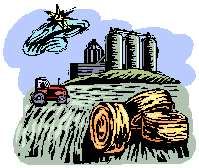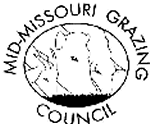

To send a message to an author, click on the author's name at the end of the article.
This Month in Ag Connection | Ag Connection - Other Issues Online
A typical hay test will analyze for moisture, protein, fiber and various minerals. Moisture is obviously the amount of water in the sample. Most hay samples run in the 10 to 15 percent moisture range.
The hay test report includes a column called "As-is" or "As-fed" and another column called "Dry Matter". Dividing the as-fed number by the percentage of dry matter in the sample converts the results to a dry matter basis. Using the dry matter basis results allows for an accurate comparison between wetter vs. drier feeds because the water content of the hay or silage is excluded from the reported dry matter nutrient results.

The nutrient most people are concerned with is protein. Crude protein is estimated by measuring the amount of nitrogen in the sample and multiplying it by 6.25. This factor is used because most forage stem and leaf tissue proteins contain 16 percent nitrogen. Higher crude protein is usually better, but must be considered in the context of plant maturity, species, fertilizer rate, nitrate concentrations, etc.
Fiber analysis is the other major component of a hay test. In the laboratory, forage samples are boiled in either a neutral detergent or acid detergent solution. After boiling, some of the sample disappears (the digestible portions) and some remains (the indigestible portions). The residues are reported as Acid Detergent Fiber (ADF) and Neutral Detergent Fiber (NDF). NDF provides an estimate of forage intake while ADF is used to calculate estimated energy levels in the forage. These energy estimates are listed as Total Digestible Nutrients (TDN), Net Energy maintenance and Net Energy gain. Since both NDF and ADF results are residues, lower numbers indicate greater intake potential and higher energy levels. Just remember that for ADF and NDF, lower is better.
The final component of most hay tests is mineral analysis. Typically calcium (Ca) and phosphorus (P) are included in a hay test package from the labs. Some labs also include potassium (K) and magnesium (Mg) in their hay test packages. For additional fees, other minerals can be measured.
Labs vary in their cost structures and packages they provide for routine forage analysis. Check with the lab to determine what test packages they offer. Unusual feedstuffs or suspected problems should be thoroughly tested. For example, hay that has heated excessively should be tested for available protein and adjusted crude protein.
Source: Gene Schmitz, MU Extension Livestock Specialist
This Month in Ag Connection | Ag Connection - Other Issues Online
A charitable gift is one of the deductions allowed as an itemized deduction on Schedule A. Taxpayers that have greater itemized deductions than the standard deduction should file Schedule A to claim their itemized deductions. The 2010 standard deduction for a single taxpayer is $5,700 and $11,400 for married filing jointly. A common question raised in calculating itemized expenses is the deductibility of certain charitable gifts.

Giving financial assistance directly to individuals who are needy or worthy, while the right and good thing to do, is not a deductible charitable contribution for tax purposes. Additionally, gifts to only certain types of organizations will qualify as deductible charitable contributions. A generalized listing of qualifying charitable organizations are:
1. A community chest, corporation, trust, fund, or foundation organized and operated exclusively for the following purposes:
2. War veterans' organizations
3. Domestic fraternal societies, orders, associations operated under the lodge system.
4. Certain nonprofit cemetery companies or corporations
5. The United States, any state, District of Columbia, a U.S. possession, a political subdivision of a state or U.S. possession, or an Indian tribal government.
Camouflaging a non-qualifying gift by routing the transfer through a qualifying charitable entity, such as a church, does not make the gift deductible. Occasionally checks are made payable to the "XYZ Church" or other charitable organization with a memo notation "for the John Doe family". The regulation dealing with this issue has a "no variance rule": all gifts to identified individuals, directly or indirectly, are not tax deductible. This non-deductibility even applies to gifts made to an individual who provides service to a qualifying charitable entity (i.e. clergy or missionaries), if the gifts can be spent as the individual desires, such as for personal expenses.
Additionally the IRS is cracking down on undocumented charitable contributions - a recently enacted rule is: "No Documentation – No Deduction". Flowing from this new documentation rule are two very important observations:
1. If you give cash to a charity – it is not deductible, unless you have a receipt.
2. If you make any single charitable contribution greater than $250 – you must have a receipt from the charity (this is true even if you have a cancelled check). A recent court case disallowed the greater than $250 contributions given to a church, when the church failed to provide a contemporaneous receipt of the contributions – even though the donor had cancelled checks to verify the donations – which amounted to several thousands of dollars.
Source: Parman R. Green, MU Extension Ag. Business Specialist
This Month in Ag Connection | Ag Connection - Other Issues Online
Poly tanks are used by many farmers and commercial operations to store various liquids. Whether a tank is a few years old or 20 years old, the only way to be sure it is structurally sound is to perform inspections before use in spring and again at the end of the application season. Just looking at a tank to determine if it is good or bad is very difficult. There are three inspection techniques to pin-point weakened areas and stressed areas around fittings.

1. Mark the tank with a water soluble marker. The inspection is performed by rubbing the marker over several six-inch by six-inch sections on the sides of the tank exposed to sun, on its top, and around fittings. Quickly rub off the ink with a dry cloth or paper towel. The ink left behind has penetrated the surface of the tank. Crazing is the development of very fine cracks within the tank wall and is one of the first signs of deterioration. So tanks with crazing should be checked often. Crazing usually appears as a network of fine lines that cannot be felt with a fingernail. Cracks on the other hand can be felt with a fingernail.
2. Candling consists of placing a bright light source inside a poly tank while conducting a visual inspection from the outside. Defects and cracks usually show up as areas or lines of different light intensity.
3. Hitting an empty tank with a baseball bat can be done to further evaluate the condition of the tank. This would be best done when the temperatures are warmer. A good tank has the flexibility to bend outward when filled and inward as it is emptied. Tanks that are brittle have lost the ability to flex under pressure and to rebound when impacted. The brittleness of an empty tank can be tested with a solid swing of a baseball bat where signs of cracking were discovered. Hit the tank along the sides and top where they receive the most sunlight; then check the tank for signs of breakage. It is impossible to crack a good tank using this method because the polymer is strong and resilient.
Another concern with storage tanks is spill coverage on your insurance policy. Many farm and commercial business policies do not cover pollution from fertilizer or pesticide spills. It is critical for business owners and farmers to consult with their insurance representatives to confirm what is and is not included in their coverage. Your insurance agent can tell whether cleanup and product replacement cost resulting from a ruptured stationary or vertical poly tank are covered under your property or vehicle policy. Policy discounts may be available for things like conducting and documenting annual and biannual inspections and for diking your storage tanks.
Source: Wayne Crook, MU Extension Agronomy Specialist
This Month in Ag Connection | Ag Connection - Other Issues Online
Soon, beef producers will begin the winter task of hauling and feeding hay to the cow herd. How and where you feed hay has a dramatic influence on the re-distribution of nutrients around the farm. Viewing hay bales as a source of fertilizer is not normally thought of, but with the price increases in fertilizer the past few years it is a topic worth discussing.
A 1,000 bale of hay contains approximately 25 pounds of nitrogen, 7.5 pounds of phosphorus and 22.5 pounds of potassium. At current fertilizer prices, this bale of hay contains a total of $26.30 worth of nitrogen (N), phosphorus (P) and potassium (K). Naturally, some of these nutrients will be used by the animal and some of the nitrogen will volatilize and be lost, but approximately $16.45 worth of fertilizer will be deposited back on the ground by the animal in the form of manure.

There is an age old debate on whether to feed hay in hay rings or to unroll bales in the pasture. There are positives and negatives to both hay feeding methods. Feeding in hay rings does reduce hay waste. Estimates are 8 to 10 percent hay waste with rings versus 15 to 20 percent hay waste by unrolling. So, feeding in hay rings saves about 9 percent of the hay being offered to the animals. If hay costs $35 per ton, feeding in hay rings saves $3.15 worth of hay.
Unrolling hay has the advantage of spreading the nutrients contained in the manure more evenly around the farm. It has the disadvantage of more wasted hay and it is not always possible or advisable to drive feeding equipment on pastures or hay fields. For a moment, though, think about the economics of wasted hay versus the fertilizer value of the manure. Is it worth your time and effort to more evenly distribute of $16.45 worth of fertilizer in the form of manure around your farm compared to losing $3.15 worth of hay and concentrating those nutrients in small areas on the farm?
If hay is constantly fed in hay rings in one location on the farm, all of the nutrients contained in the hay are transferred from the hay fields to the hay feeding area. This can be avoided by either moving the hay rings around to various locations on the farm or by unrolling hay.
There isn't a definite answer to the debate of feeding in rings vs. unrolling hay. However, consider the fertilizer value contained in hay and ask yourself if you are taking full advantage of that resource. Also consider if a different way of feeding hay is possible on your farm. Being open to alternatives is becoming more and more important to beef cattle producers.
Source: Gene Schmitz, MU Extension Livestock Specialist
This Month in Ag Connection | Ag Connection - Other Issues Online


February 10, 2010
Capital Plaza Hotel - 415 W. McCarty - Jefferson City, MO
8:30am - 3:30pm
Terry Gompert - Grazing & Alternative Forage Systems for Beef Cattle
Dr. Tom Lenz - Impact of Animal Welfare Issues on Livestock Production
Dr. Scott Poock - Handling Calving Difficulties in Beef Cattle
Come see the Trade Show beginning at 8:30 a.m. (Morning sessions begin at 9:30 a.m.)
- Value Added Marketing Options for Livestock
- Mob Grazing
- Weed & Brush Control w/ Sheep & Goats
- Grazing Wedge Use in Beef Cattle Operations
- Understanding & Using Electric Fencing Materials
- What Beef Producers Can Learn From Grazing Dairy Forage Systems
Advanced registration by Feb. 4th, 2011: $40.00 individual or $60 couple
Late/Door Registration: $50 individual or $70 couple
Includes: Meal, Refreshments & Proceedings
To Register, Send check to: Cole County SWCD, 1911 Boggs Creek Rd, Jefferson City, MO 65101
For more information: Ed Gillmore or Peggy Lemons at 573-893-5188 ext. 3
This Month in Ag Connection | Ag Connection - Other Issues Online
Publishing Information
Ag Connection is published monthly for Northeast and Central areas of Missouri producers and is supported by the University of Missouri Extension, the Missouri Agricultural Experiment Station, and the MU College of Agriculture, Food and Natural Resources. Managing Editor: Mary Sobba.